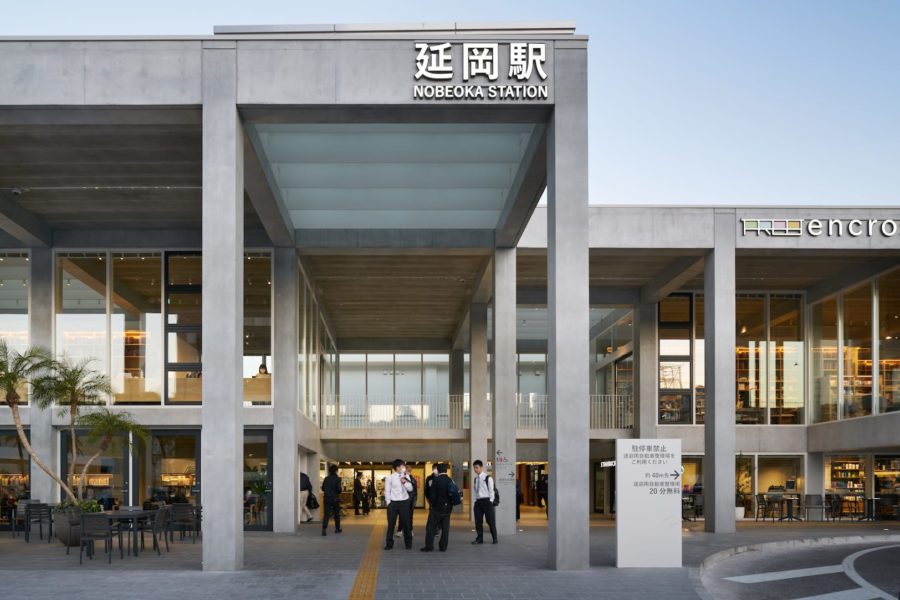京急線の終着駅にあり、古くから港町として発展してきた浦賀の街にある、中古マンションリノベーションの計画。
壁式コンクリート造の建物では、住空間の中にコンクリートの壁や梁が横断し、間取りの変更に大きな制約となる。この硬く重いコンクリートの存在を否定することなく、地形として活かすことで最小限の操作で住空間を構成していくことを考えた。
大まかな間取りをコンクリート壁にゆだね、不足分を補うように梁下に高さを抑えたシナ合板の家具を配置した。家具は梁と無関係に配置すれば空間を分ける「仕切り」となり、梁に沿って配置すれば空間を分断する「間仕切り」となる。
その結果、耐力壁のない側はゆるやかに仕切られた大きなワンルーム空間となり、風と光が住戸の奥まで届くようになった。一方、耐力壁で仕切られた側は自然と個室に分断されるため、水回りや寝室などの機能を配置した。ワンルーム空間は冗長的にならないよう、床段差や造作家具、袖壁などで変化を与えている。
デスク付きのWICやインナーバルコニーと玄関には、居場所を想起させるものとして造作ベンチを置き、50m²の住空間を全体的に使える状態をつくった。
硬い地形に対し、柔らかい家具を挿入することで多様な性格の場を散りばめ、新たな地形をつくっている。その新しい地形を読み解きながら生活が行われる、環境のような住空間を目指した。(鎌松 亮)
Renovation of a condominium reconstructed while yielding to the structure
This is a project to renovate an existing condominium in the town of Uraga, which is located at the terminus of the Keikyu Line and has developed as a port town since ancient times.
In a walled concrete building, concrete walls and beams cross over into the living space, a major restriction on changes to the floor plan. Without denying the existence of this hard and heavy concrete, the idea was to utilize it as a topography to compose the living space with a minimum of manipulation.
We left the general floor plan to the concrete walls and placed furniture made of low-height linden plywood under the beams to compensate for the lack of space. Furniture becomes a “partition” that divides space independently of the beams and a “partition” that divides space if placed along the beams.
As a result, the side without the bearing wall becomes a large one-room space that is loosely partitioned, allowing wind and light to reach the back of the dwelling. On the other hand, the side partitioned by the bearing wall is naturally divided into private rooms, where functions such as water and bedrooms are located. To prevent the one-room space from becoming redundant, changes were made to floor levels, built-in furniture, and sleeve walls.
A WIC with a desk, an inner balcony, and a built-in bench at the entrance was placed as reminders of the place to stay, creating a state where the 50m² living space can be used as a whole.
By inserting soft furnishings into the hard terrain, a new topography was created by scattering various places with different characteristics. We aimed to create a living space where people can live while deciphering this new topography. (Ryo Kanematsu)
【浦賀の住宅】
所在地:神奈川県横須賀市浦賀
用途:共同住宅・集合住宅
クライアント:野村産興
竣工:2020年
設計:note architects
担当:鎌松 亮
施工:野村産興
撮影:Hiroki Kawata, Noa Asanuma
工事種別:リノベーション
構造:RC造
延床面積:52.28m²
設計期間:2019.09-2019.12
施工期間:2020.05-2020.08
【house in uraga】
Location: Uraga, Yokosuka-shi, Kanagawa, Japan
Principal use: Housing complex
Client: Nomura sanko
Completion: 2020
Architects: note architects
Design team: Ryo Kamamatsu
Contractor: Nomura sanko
Photographs: Hiroki Kawata, Noa Asanuma
Construction type: Renovation
Main structure: Reinforced Concrete construction
Total floor area: 52.28m²
Design term: 2019.09-2019.12
Construction term: 2020.05-2020.08








